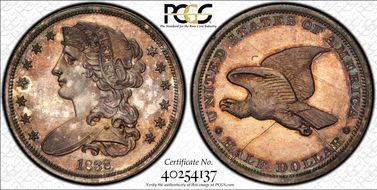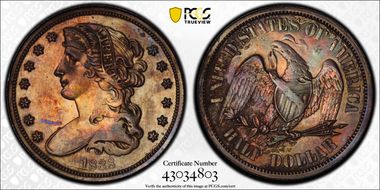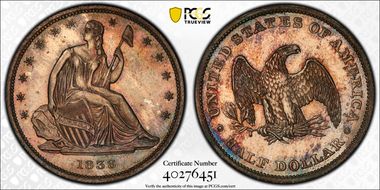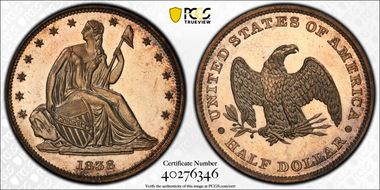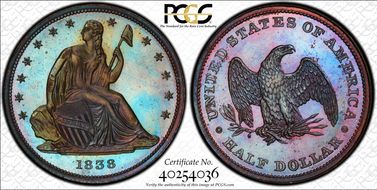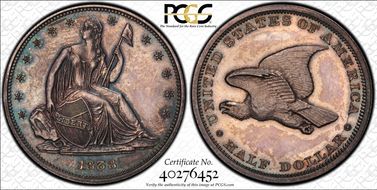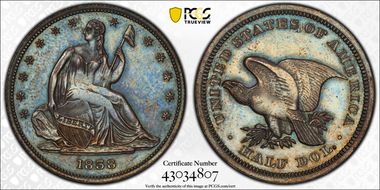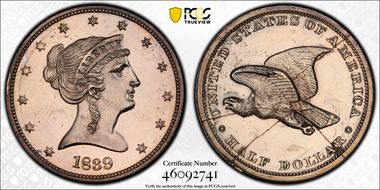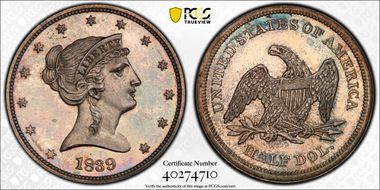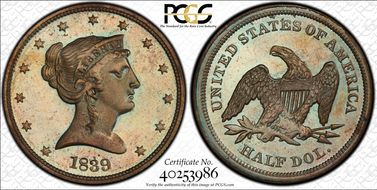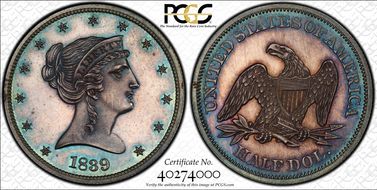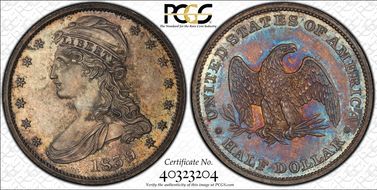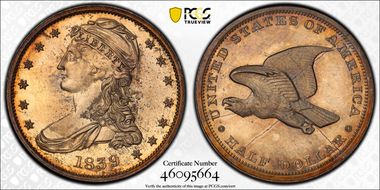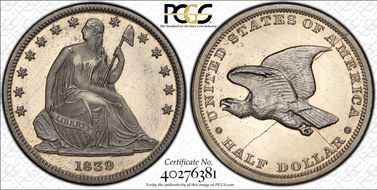Dauntless Early American Collection of 1838 and 1839 Pattern Half Dollars 的钱币相册
Judd-73 R.5. CAC. Simpson Lot 3039. Per cataloger, "Judd-73 Restrike, Pollock-77, R.5, PR64+ PCGS. CAC. Ex: Simpson. A draped bust of Liberty faces left on the obverse, with a flying eagle dominating the reverse. Kneass was once believed to designed this pattern, but visual evidence points to Christian Gobrecht, since the face of Liberty bears a strong resemblance to her counterpart on the ten dollar Liberty, also introduced in 1838. Struck in silver with a reeded edge. Medallic alignment. Probably all Judd-73 halves are restrikes, since the three prominent radial cracks on the reverse do not appear on Judd-79 patterns, which were struck in 1838. The obverse exhibits mottled gray-rose toning with occasional dabs of brilliance showing, while the reverse has a pronounced reddish hue with cobalt-blue around the margins." Obtained from Heritage Auction of Robert Simpson Collection on August 18, 2021.
Judd-74. R8+. Unique. Norweb. Simpson. Copper version of Judd-73 in (Was in Simpson bought as NGC MS66BN). Lot 3098. Per cataloger, "Unique Judd-74 Restrike, Kneass Design PR66BN PCGS. Per cataloger, "Ex: Simpson. The obverse displays the William Kneass ("the last work executed by him," according to Judd, before his debilitating 1835 stroke) left-facing draped Liberty Head design (used on Judd-72 to Judd-75) showing an expansive bustline, wearing a coronet reading LIBERTY, 13 stars separated seven and six around the rim, the date 1838 below. The reverse design, attributed to Christian Gobrecht, features a crimp-necked eagle flying left with UNITED STATES OF AMERICA and HALF DOLLAR around. Four or five die cracks radiate to the rims from the central areas. Both the advanced die cracks and extensive die rust on both sides peg this coin as a late-state restrike dating to the 1870s, called by USPatterns.com a "fantasy piece." Struck in copper with a reeded edge. These dies have a long and fascinating history. Although "originals" (Judd-73, silver, reeded edge) are supposedly known, none survive with no die cracks. Such coins would weigh the statutory standard for 1838 of 206 grains, and would likely have been placed in the Mint Cabinet, formed in that same year -- yet none are there. The earliest die state examples known of the reverse die are a handful of Judd-79 coins (with Liberty Seated obverse, silver, reeded edge), showing a die crack running through F DOLLAR AMERICA. Ex: Woodside Collection (New York Coin & Stamp, 4/1892), lot 21; 22nd Sale (Thomas Elder, 12/16/1908), lot 954; to A.F. Holden; Norweb Collection; New Netherlands 41st Sale (9/1953), Macy's (6/1954), lot 1549; ANA Signature (Heritage, 8/2008); Simpson Collection." Obtained from Heritage Auction of the Simpson Collection Part 2 on November 19, 2020, Lot 3098.
Judd-75b. R8. Liberty Facing Left Half Dollar. Two Known. Copper with a Reeded Edge. Per cataloger, "Perhaps only 2 known. NGC PR62 Brown. Judd-75b (formerly Judd-255), Pollock-81, R.8, PR62 Brown NGC. This mule pairs the Kneass-designed obverse with the bust of Liberty facing left, with the Paquet-designed reverse from 1859 that shows a perched eagle. Struck in copper with a reeded edge. Only two examples of this rare muling are believed known, and both are believed to have come from the Farouk collection. The surfaces are richly toned in multiple shades with significant brightness radiating from the fields. Ex: Auction '81 (RARCOA's session, 7/1981), lot 322; Stewart Witham to Harry Bass, August 12, 1981; Bass I (Bowers and Merena, 5/1999), lot 1146." Obtained from Heritage Auction #1279 on September 6, 2018, Lot 3290.
Judd-76 R8. CAC. Simpson. Two Known. Silver Restrike with plain edge. Per cataloger, "Judd-76 Restrike, Pollock-83, R.8, PR63 PCGS. CAC. Ex: Simpson. The obverse is similar to the adopted design with only slight differences. The reverse, however, is noticeably different, with a spread-winged eagle that holds four arrows and a laurel branch. Struck in silver with a plain edge. The restrikes, such as seen here, show scattered die rust on the reverse and are believed to have been struck in the 1870s. The surfaces on each side are toned in different hues, with the obverse pale blue while the reverse is golden. The fields are bright and reflective throughout. Sharply detailed on the obverse, but the reverse shows just a bit of softness on the eagle's breast feathers." Obtained from Heritage Auction of Robert Simpson Collection Part 6 on 2021, Lot Simpson. Lot 3040. Silver Restrike with plain edge. Per cataloger, "Judd-76 Restrike, Pollock-83, R.8, PR63 PCGS. CAC. Ex: Simpson. The obverse is similar to the adopted design with only slight differences. The reverse, however, is noticeably different, with a spread-winged eagle that holds four arrows and a laurel branch. Struck in silver with a plain edge. The restrikes, such as seen here, show scattered die rust on the reverse and are believed to have been struck in the 1870s. The surfaces on each side are toned in different hues, with the obverse pale blue while the reverse is golden. The fields are bright and reflective throughout. Sharply detailed on the obverse, but the reverse shows just a bit of softness on the eagle's breast feathers." Obtained from Heritage Galleries Auction of the Robert Simpson Collection Part 6 on August 18, 2021, Lot 3048.
Judd-76a. R8. CAC. Simpson. Two Known. Per cataloger, "1838 Half Dollar in Silver. Judd-76a Restrike, PR64+. Just Two Pieces Known. 1838 P50C Seated Liberty Half Dollar, Judd-76a Restrike, Pollock-82, R.8, PR64+ PCGS. CAC. Ex: Simpson. The obverse is similar to the adopted Seated Liberty design. Differences include an incuse LIBERTY and a wide, slightly curved date. The reverse is noticeably different, with a spread-winged eagle that holds four arrows and a laurel branch. Struck in silver with a reeded edge. The die combination was also struck in silver with a plain edge (Judd-76), and in copper with a plain (Judd-77) and reeded (Judd-78) edge. All are believed to be struck during the 1870s, due to die rust evident on the reverse. Originals (Judd-76b) were coined in silver only, from a different obverse die with LIBERTY raised, and a rust-free reverse. This well-preserved near-Gem exhibits attractive original rose-gold, navy-blue, plum-red, and apple-green toning. The strike shows moderate incompleteness on the eagle's breast and legs. There are no relevant detractions. Only two Judd-76a patterns are confirmed, the present lot and the Witham-Queller specimen we auctioned in January, July, and September 2009. Ex: Édouard Frossard; T. Harrison Garrett; Robert Garrett; John Work Garrett; Johns Hopkins University; Garrett Collection, Part 1 (Bowers and Ruddy, 11/1979), lot 364; Harry W. Bass, Jr. Collection, Part I (Bowers and Merena, 5/1999), lot 1147; Elite Coin Auction (Superior, 4/2003), lot 240." Obtained from Heritage Galleries Auction of the Robery Simpson Collection Part 3 on January 20, 2021, Lot 3061.
Judd-76b. R.8. PR63 Cameo. CAC. Eliasberg. Simpson. Two Known (one in the Smithsonian). Silver original with reeded edge. Lot 3123. Per cataloger, "Only Two Known, Unique in Private hands. Judd-76b, Pollock-89a, R.8, PR63 Cameo PCGS. CAC. Ex: Simpson. 200.8 grains, per the Eliasberg catalog. The obverse is similar to the adopted design with only slight differences. LIBERTY is raised on the shield and each star has two points near the border, compared to a single point near the border on the 1839 regular issue. The reverse is noticeably different, with a spread-winged eagle that holds four distinctively-shaped arrows and a laurel branch, the legend UNITED STATES OF AMERICA around, and the denomination HALF DOLLAR below. Struck in silver with a reeded edge. The description in the 1996 Eliasberg catalog noted that this was an unlisted pattern variety and the first time it was described. Since that time, the other known example, permanently in the Smithsonian Institution, has been properly identified as this same Judd-76b variety, having received an improper identification in eight editions of Judd, and in the Pollock reference. The present example is extraordinarily important as the only known piece in private hands. Exceptionally well struck with delicate gold toning and iridescent splashes. Ex: Louis E. Eliasberg, Sr. (Bowers and Merena, 5/1996), lot 232; Superior (9/1999), lot 1414; Superior (1/2004), lot 3423; Southern Collection. Earlier, Ex: Mickley, Cohen, Ely, H.P. Smith, and J.H. Clapp Collections."
Judd-77. R7+. Simpson. Four Known. Per cataloger, "Judd-77 Restrike, Pollock-85, High R.7 PR66+ Red and Brown PCGS. Ex: Simpson. The obverse features the regular-issue No Drapery design, while the reverse has a heraldic eagle in the center that is similar to the two cent patterns from 1836. Struck in copper with a plain edge. Four examples of Judd-77 are known. These, like other patterns of this type in different metal/edge combinations, were actually produced during the 1870s. Heavy die rust on the reverse is a telltale diagnostic for restrikes, as is the incuse LIBERTY on the obverse. Both sides are glossy brown with iridescent accents of violet, olive-gold, and bluish toning when rotated. The coin is near-flawlessly preserved and virtually fully struck, save for a touch of softness on the eagle's breast. Ex: Greenwald and Jackson Collections (Bowers and Merena, 9/1995), lot 1632; Fixed Price List (Heritage, 5/1997); Lindesmith Collection (Bowers and Merena, 3/2000), lot 2025; Pre-Long Beach Sale (Superior, 10/2000), lot 4435." Heritage Galleries Auction of Robert Simpson Collection Part 6 on August 18, 2021, Lot 3041.
Judd-78. R7+. CAC. Simpson. PR66+RB. Copper Restrike. Per cataloger, "1838 Seated Liberty Half Dollar in Copper. Judd-78 Restrike, PR66+ Red and Brown. Only Four Confirmed Examples. 1838 P50C Seated Liberty Half Dollar, Judd-78 Restrike, Pollock-84, High R.7 PR66+ Red and Brown PCGS. CAC. Ex: Simpson. The obverse features Liberty seated on a rock with shield and pole. A scroll draped across the shield has the inscription LIBERTY in incuse letters. Thirteen stars around and the date below. The reverse shows an eagle with wings spread holding an olive branch and four arrows. The legend UNITED STATES OF AMERICA around and the denomination HALF DOLLAR below. Medallic turn. Struck in copper with a reeded edge." Obtained from Heritage Auction of Robert Simpson Collection Part 5 on April 23, 2021, Lot 4191 [Actually purchased immediately after the auction from the purchaser]. Judd-76 through Judd-78 are restrikes, possibly made during the 1870s. Their original counterparts feature the letters in LIBERTY raised on the shield and were only struck in silver. USPatterns.com confirms four examples of Judd-78. This Premium Gem with added recognition from PCGS and CAC is largely copper-orange with accents of pastel blue, green, and violet that are especially noticeable on the reverse. Well-preserved with a trace of softness on the eagle's right (facing) leg. Ex: Stewart Witham; Auction '81 (RARCOA, 7/1981), lot 316; Dallas Auction (Heritage, 6/1989), lot 1467; Morris Evans Collection (Bowers and Merena, 8/1998), lot 2034; Higman-Alterman (Larry Hanks/Mal Varner offering); Robert W. Schwan Collection (Bowers and Merena, 10/2000), lot 2018; Public Auction sale (Superior, 4/2003), lot 241.
Judd-79. R7+. Bass. Simpson. Dupont. Five Known. Silver. Per cataloger, "1838 Seated Liberty Half in Silver. Judd-79 Original, PR63. Ex: Bass, One of Five Known. 1838 P50C Seated Liberty Half Dollar, Judd-79 Original, Pollock-89, High R.7, PR63 PCGS. Ex: Bass-Simpson. 201 grains, per its Auction '81 catalog appearance. The obverse displays the Seated Liberty design, close to the one adopted for circulation strikes, with the date slightly curved and the word LIBERTY raised on the shield. The reverse shows Gobrecht's Flying Eagle design, with UNITED STATES OF AMERICA on the upper rim and HALF DOLLAR at the lower margin. Struck in silver with a reeded edge. Medallic alignment. All examples of Judd-79 are originals, and lack the radial cracks seen on the reverses of the Judd-79a restrikes, which also show LIBERTY incused. The strike is fairly sharp, with only slight blending on the breast feathers of the high-relief eagle. The borders show ocean-blue toning, while the open fields display pastel pink and gold shades. The grade is limited solely by a narrow mark between stars 6 and 7. USPatterns.com confirms only five different specimens of Judd-79. Ex: Anderson Dupont Collection (Stack's, 11/1954, lot 2105; Witham Collection / Auction '81 (RARCOA, 7/1981), lot 317, Harry W. Bass, Jr.; Harry W. Bass, Jr. Research Foundation; Chicago ANA Signature (Heritage, 8/2014), lot 5794." Obtained from Heritage Galleries Auction of the Robert Simpson Collection on January 20, 2021, Lot
Judd-79a R7-. Eliasberg. Essai. "Incuse liberty obverse (so-called straight date) only original from this obverse die. The reverse die is in its earliest known state with die cracks only through "F Dollar * America". At least one was struck by W.E. Dubois for Matthew Stickney as there is a letter dated July 12, 1843 in the Peabody Essex Museum," per uspatterns.com. Per cataloger, "Ex: Eliasberg. The obverse is similar to the adopted design of 1839. The reverse is an early impression from Gobrecht's flying eagle design, which makes this coin a reduced version of the Gobrecht dollar. Struck in silver with a reeded edge. This is the so-called "Straight Date" variant of Judd-79, of which only a dozen or so pieces are known. The surfaces are bright and mostly pearl-gray with wisps of golden-brown and blue toning around the margins. A rare and infrequently offered pattern. Ex: Chapman Brothers April 1897 Sale; J.M. Clapp; Clapp Estate, 1942, to Louis E. Eliasberg, Sr.; Eliasberg Collection (Bowers and Merena, 5/96), lot 233, where it brought $7,920; Long Beach Signature (Heritage, 5/2003), where it realized $12,650. From The Collection of William Rau." Crossed from NGC PR63 [615406-024] to PCGS PR62 in 2021. Obtained from Heritage Auction #1284 on April 26, 2018, Lot 4483.
Judd-80 R7+. Simpson. Five Known. Restrike? in Silver with Reeded Edge. Per uspatterns.com, "Incuse liberty obverse (so-called straight date) the reverse not believed to have existed until the mid 1860s. To my knowledge, no originals were ever made using this reverse die. In fact, I believe that this die was actually finished many years later either in the late 1860s or early 1870s. This appears to be the last use of this obverse die as there is a crescent shaped bulge or clash to the left of Liberty's right arm, as shown below courtesy of PCGS, which does not appear on any other restrikes using this obverse die." Per Heritage cataloger, "Seated Liberty Half Dollar, Judd-80 Restrike, Pollock-87, High R.7, PR63 NGC. The obverse design is a slightly modified Seated Liberty motif, with the rock larger, the stars spaced differently, and Liberty's drapery rearranged. The word LIBERTY is incused on the scroll. The date is in the exergue. The reverse features a "defiant" eagle, clutching an olive branch and six arrows, with the legend UNITED STATES OF AMERICA around and HALF DOL. below. Struck in silver with a reeded edge. The Judd-80 is apparently a restrike from the late 1860s or early 1870s. Only a half dozen examples are known in silver and copper. While termed a restrike, no originals are known. The strike is weakly defined in the center of each side, most likely because the relief was too high on both obverse and reverse. As a result there was not enough metal to fill the recesses of the design. The color is well-balanced with brown and blue patina intermixed throughout. From The Bob Simpson Collection" Provenance: Heritage August 11, 2010, Lot 3700. Obtained by private treaty with Park Avenue Numismatics on August 6, 2014.
Judd-81. R7. Eight known. Restrike Seated Half Dollar in Copper. Per USpatterns.com, "This s a "restrike" made in the late 1860s or early 1870s from the regular die having Liberty incused on the shield. This is Judd's so-called straight date variety. To my knowledge, no originals were ever made using this reverse die. In fact, I believe that this die was actually finished many years later either in the late 1860s or early 1870s. This appears to be the last use of this obverse die as there is a crescent shaped bulge or clash to the left of Liberty's right arm, as shown below courtesy of PCGS, which does not appear on any other restrikes using this obverse die. Copper J81/P88 with the following 8 believed to exist. Its first auction appearance was in Haseltine's February 1877."
Judd-82. R8. Farouk. Essai. Two Known. Original Silver with Reeded Edge. Per USpatterns.com, "The rare transitional issue featuring the obverse with raised Liberty, the so-called "Curved Date", combined with the regular reverse die used on 1837 half dollars. Only 2 are confirmed and both are originals with confused pedigrees. Farouk, Krouner, Coronet Coin FPL, Merkin 2/71, StacksBowers 8/13 ANA." Obtained by private treaty from David Wynuk and Andy Lustig on April 29, 2014.
Judd-91 R.8. Bass. Farouk. Silver Restrike Half Dollar. Per cataloger, "Judd-91 Restrike, Terrific Pedigree, Only Two Known, One in Private Hands. (the other in Durham museum). Pollock-101, R.8 PR63 PCGS. Ex: Harry W. Bass, Jr. Collection. The obverse has a bust of Liberty, facing right, with thirteen stars around and the date 1839 below. Liberty's hair is knotted in a bun, and a long curl trails below the ear. This obverse is similar to the one used on 1838 eagles but it faces the other way. This particular design uses the regular 'Small Letters' reverse die of 1839. The reverse shows a Flying Eagle design, with UNITED STATES OF AMERICA on the upper rim and HALF DOLLAR at the lower margin. Struck in silver with a reeded edge. This remarkable rarity enjoys a pedigree that reads like a who's who of pattern collecting. Pale rose-gold patina drapes each side. A few small stray marks are noted and the impression is a bit incomplete, but those traits are entirely inconsequential. This will serve as the only example of Judd-91 in private hands. Ex: William H. Woodin; Waldo C. Newcomer; F.C.C. Boyd; King Farouk; Palace Collections of Egypt (Sotheby's, 2/1954), lot 1732; J. Hewitt Judd, Krouner-Coronet FPL #75; Stewart Witham; Auction '81 (RARCOA, 7/1981), lot 363." Obtained from Heritage Auction of the Bass Collection Part 1 on September 29, 2022, Lot 11073.
Judd-93. R7. Silver. Eight Known (3 in museums: Smithsonian, Bass Foundation, Byron Reed Museum). Per cataloger, "1839 Original Half Dollar, Judd-93, PR66. Finest Certified, Possibly Sole Finest Known. 1839 P50C Half Dollar Judd-93 Original, Pollock-105, R.7, PR66 PCGS. CAC. The obverse design resembles used on the 1839 gold eagles including the rounded forward bust truncation and pointed rear truncation, but the bust of Liberty faces right rather than left. The reverse employs the regular Small Letters die of the year. Per the authoritative USPatterns.com website, the Judd-93 coins are the only original patterns using this obverse die, of which perhaps seven survive today. (Several of those examples, however, are in institutional holdings.) Struck in silver with a reeded edge. This problem-free piece boasts incredible eye appeal on surfaces that show excellent preservation amid the beautiful medium blue tones around the peripheries with pale lavender centers on each side. This PR66 PCGS piece is possibly the sole finest known and apparently the finest certified. It is the finest at PCGS by two grade points; the finest at NGC is a single PR65 (11/14). From The A. James Evans Collection, Part II." Obtained from Heritage Galleries Auction on January 7, 2021, Lot 4492.
Judd-93. R7. Silver. Eight Known (3 in museums: Smithsonian, Bass Foundation, Byron Reed Museum). Per cataloger, "1839 Original Half Dollar, Judd-93, PR66. Finest Certified, Possibly Sole Finest Known. 1839 P50C Half Dollar Judd-93 Original, Pollock-105, R.7, PR66 PCGS. CAC. The obverse design resembles used on the 1839 gold eagles including the rounded forward bust truncation and pointed rear truncation, but the bust of Liberty faces right rather than left. The reverse employs the regular Small Letters die of the year. Per the authoritative USPatterns.com website, the Judd-93 coins are the only original patterns using this obverse die, of which perhaps seven survive today. (Several of those examples, however, are in institutional holdings.) Struck in silver with a reeded edge. This problem-free piece boasts incredible eye appeal on surfaces that show excellent preservation amid the beautiful medium blue tones around the peripheries with pale lavender centers on each side. This PR66 PCGS piece is possibly the sole finest known and apparently the finest certified. It is the finest at PCGS by two grade points; the finest at NGC is a single PR65 (11/14). From The A. James Evans Collection, Part II." Obtained from Heritage Galleries Auction on January 7, 2021, Lot 4492.
Judd-95. R8. Garret. Simpson. Two Known. Restrike in Silver. Per cataloger,"1839 'Backward Head' Half in Silver. Judd-95 Restrike, PR66. Ex: Garrett-Bass. 1839 P50C Half Dollar, Judd-95 Restrike, Pollock-103, R.8, PR66 PCGS. Ex: Garrett-Simpson. Sometimes called the Backward Head, this pattern features an obverse much like that found on the regular-issue 1839 gold eagles, with a rounded tip on the forward edge of the bust truncation and a pointed tip on the rear edge -- but the entire head is facing backward from that on the eagle, right rather than left. Thirteen stars ring the rim, with date 1839 below. The reverse is from the regular-issue Seated Liberty die, Medium Letters, as seen on the 1840 half dollars. Struck in silver with a reeded edge. Only two pieces are known in silver. All of the various half dollar patterns of 1838 and 1839 are incredibly rare to unique -- with the sole exceptions of the Judd-72 and 73 in silver -- and all are monumentally important. These pieces represent a profound shift in design, from the older Capped Bust style to more-modern designs, and as such are significant previews of the future of U.S. silver coinage. Much of the original silver surface remains on each side with additional layers of pale blue and rose toning. The strike is fully brought up in all areas. Ex: Édouard Frossard; T. Harrison Garrett; Johns Hopkins University; Garrett Collection, Part I (Bowers and Ruddy, 11/1979), lot 366; Auction '81; Harry Bass Collection, Part I (Bowers and Merena, 5/1999), lot 1153; Rarities Sale (Bowers and Merena, 5/2004), lot 556; Southern Collection." Obtained from Heritage Auction of the Bass Collection Part 5 on April 23, 2021, Lot 4193.
Judd-96 R8. Simpson. Three Known (one in museum). Copper with a reeded edge. Per cataloger, "Backward Head, Judd-96 Restrike, Pollock-104, R.8, PR66 Brown PCGS. Ex: Simpson. Sometimes called the Backward Head, this pattern features an obverse much like that found on the regular-issue 1839 gold eagles, with a rounded tip on the forward edge of the bust truncation and a pointed tip on the rear edge--but the entire head is facing backward from that on the eagle, right rather than left. Thirteen stars ring the rim, with date 1839 below. The reverse is from the regular-issue Seated Liberty die, Medium Letters, as seen on the 1840 half dollars. Struck in copper with a reeded edge. There are only three pieces believed known in copper (two in silver). The fields are moderately reflective and considerably enliven the lovely iridescent brown, pale red, and blue coloration. This evenly balanced coin has no detracting contact marks, and just a bit of slight strike softness appears in the centers of each side. Ex: Stewart Witham; Auction '81 (RARCOA, 7/1981), lot 326; Lemus-Queller Collection / FUN Signature (Heritage, 1/2009), lot 1522." Heritage Auction of Bob Simpson Collection #6 on August 18, 2021, Lot 3042.
Judd-97. R7+. Simpson. Four Known (one in Smithsonian). Silver. Restrike. Per cataloger, "The Backward Liberty. Judd-97 Restrike, Pollock-107, High R.7, PR65 PCGS. CAC. Ex: Simpson. The obverse depicts a figure of Liberty facing right on the obverse, mouth open, hair tied in a bun, one curl draping down the neck behind the ear, sporting a coronet reading LIBERTY, rounded forward bust and pointed rear bust, 13 stars around, date 1839 below. The reverse offers the regular Large Letters die seen on some regular-issue 1839-dated half dollars. Struck in silver with a reeded edge. The design is called "Coronet Head facing right" in Judd, but it is sometimes known as the "Backward Liberty." It is strongly reminiscent of the ten dollar Coronet Head gold coins of 1838 and 1839 in the dangling curls and sharply pointed rear bust, but it nonetheless just looks decidedly odd. Because the profile of Liberty faces right rather than left, the LIBERTY on the coronet begins with the L behind the ear and the last letter Y is above the forehead. Judd comments that "neither this die nor any like it were ever used for coinage". This example shows die rust most perceptible on the profile of Liberty, although less so than on many of these 1860s- or 1870s-era restrikes. Lovely pale-blue and plum-rose patina prevails on well-mirrored surfaces, an extremely attractive coin. Perhaps four or five exist including the Smithsonian example, with this piece certainly among the finest. Population: 1 in 65, 0 finer (10/20). Ex: Anderson DuPont (Stack's, 11/1954), lot 2416; River Oaks (Bowers and Ruddy, 11/1976), lot 964; Stewart Witham-Auction '81 (RARCOA, 7/1981), lot 327; Morris Evans Collection (Bowers and Merena, 8/1998), lot 2037; Superior (5/2003)." Heritage Auction of Bob R. Simpson Part 2 on November 19, 2020, Lot 3100.
Judd-98. R7+. CAC. Six Known (one in Byron reed Museum). Copper Restrike. Lot 5229. Per cataloger, "Judd-98 Restrike, Pollock-108, High R.7, PR64+ Red and Brown PCGS. CAC. The backward or right facing Liberty head design is similar to the one appearing on the 1839 half eagles and eagles. Liberty wears a coronet inscribed LIBERTY with her hair tied at the back of her head. The date, 1839, appears below the bust with 13 stars equally spaced along the border. The reverse is the regular issue No Motto half dollar design with Large Letters as used from 1842 to 1853 and from 1856 to 1866, and produced in the 1870s. Struck in bronze with a reeded edge. The bright red-yellow surfaces are mellowed just a couple of shades into the brown zone, but just barely. Highly reflective proof fields and fully struck throughout." One reported [I don't know if its mine]From Kagin's 304th Sale: M.A.N.A. - Washington 1974Public & Mail Auction November 1-2, 1974, Lot 1866, per Kagin cataloger on page 123, :1839 J-98 bust right/rev. regular dies of 1842 to 1845, copper restrike, Red PROOF. RARITY 8! ONLY 2 or 3 KNOWN [actually 6] On a comparitive scale with similar desirable patterns are bringing, this Great Rarity should realize upwards of ..." Obtained from Heritage Galleries Auction on January 4, 2018, Lot 5229.
Judd-99. R8. Simpson. Two known. Per Heritage cataloger, "Judd-99 Restrike, Pollock-109, R.8 PR64 PCGS. Ex: Simpson. The obverse is the regular Capped Bust half dollar die as used from 1836 through 1839. The reverse shows an eagle with its head turned right (facing), with olive branch in the left talon and four arrows in the right. The usual legends encircle the rim. Struck in silver with a reeded edge. The reverse design will be instantly familiar to students of U.S. coinage, as it is similar to that used on the short-lived twenty cent coinage of 1875 through 1878. The arrows and olive sprig are switched, and other minor details vary, but there is no mistaking the many similar elements. The obverse was also used on Judd-72 of 1838. The weight of the Garrett-Bass-Simpson specimen is recorded as 192 grains, which would place it in the category of mid-19th century (or later) restrike. Saul Teichman of USPatterns.com calls these restrikes made for sale in the 1870s, as evidenced by the heavy die rust prominent on both sides. The obverse is gray with minor accents of yellow and rose. The reverse, on the other hand, displays rich blue patina with some cherry-red still remaining in the center. Ex: Édouard Frossard; Garrett-Johns Hopkins University (Bowers and Ruddy, 11/1979), lot 367; Harry W. Bass, Jr. Research Foundation; Bass Collection (Bowers and Merena, 5/1999), lot 1157; Southern Collection; Simpson Collection." Was PCGS PR63+ CAC then upgraded. Heritage Auction of Bob Simpson Collection #1 on September 17, 2020, Lot 10171.
Judd-100. R.8. Bass. Finest of Two Known. Restrike in Silver. Bass. Per Heritage cataloger, "Judd-100 Restrike. Finest of Two Known. 1839 P50C Capped Bust Half Dollar, Judd-100 Restrike, Pollock-110, R.8, PR66 PCGS. Ex: Harry W. Bass Collection, Jr. Collection. The obverse is the regular Capped Bust (1836-1839) die, with date 1839. The reverse is a Flying Eagle design with plain field, similar to the Flying Eagle cents but with an awkward crook in the neck. The usual legends surround the rim. Struck in silver with a reeded edge. Medallic turn. This restrike was made in the 1870s for sale to collectors, according to USPatterns.com. Both obverse and reverse dies show heavy rust, and there are extensive die cracks on the reverse. Only two examples are known, this piece and the ex: Queller-Simpson example that was graded PR63 NGC. At the time this piece was sold by Lester Merkin in 1971 it was the only one known and the discovery piece. Merkin noted something in the catalog that we missed on our initial examination of the piece: "Curved line on drapery and bosom, as made -- a second glancing blow of the blank cutter on this planchet." We would add the curved line extends faintly into the lower-right obverse field also to star 10. However, there is no trace in the left-obverse field, if it was there at the time of striking evidence of it was most likely polished away. The obverse fields show extensive die polishing marks, as well as heavy die rust; the reverse displays almost no die polishing and only small, scattered areas of die rust. The fields are nicely mirrored and both sides display light, even rose toning. William H. Woodin Collection; Waldo C. Newcomer Collection; F.C.C. Boyd Collection; Dr. J. Hewitt Judd Collection; Illustrated History of United States Coins (Dr. J. Hewitt Judd Collection) (Abe Kosoff, 1/1962), lot 121; Burton (or Barton) W. Krouner Collection (A "Gentleman's Study Collection" of United States Half Dollars) (Coronet Coin & Stamp, circa 1968-1969), lot 9; (Lester Merkin, 2/1971), lot 860; Harry W. Bass, Jr. Foundation Collection (HBCC# 6013). The present coin. Plated in United States Pattern, Trial, And Experimental Pieces by Edgar H. Adams and William H. Woodin; plated in United States Pattern, Experimental and Trial Pieces by Dr. John Hewitt Judd." Obtained from Heritage Auction of Bass Collection Part III on May 4, 2023, Lot 4588.
Judd-101. R8. Farouk. Bass. Simpson. Silver Restrike. Per cataloger, "Judd-101 Restrike, Pollock-112, R.8, PR63 PCGS. Ex: Bass-Simpson. The year 1839 marked the transition for half dollars from the old, venerable Capped Bust design -- with reeded edges since 1836 when steam presses took over -- to the new Liberty Seated design, launched first on half dimes and dimes in 1837 before spreading to other denominations in ensuing years. The Judd-101 half dollars are struck in silver with plain edges, featuring the Liberty Seated, With Drapery motif on the obverse. The reverse, however, is the Standing Eagle reverse, a perched eagle facing to the viewer's right sans shield and holding four arrows and an olive branch, as seen on the Judd-76 to Judd-78 issues of 1838. The Judd-101 patterns are restrikes from rusted dies oriented in medallic turn. Only two are known, the other being the John J. Pittman Collection example, PR67 NGC, which we offered in our FUN Signature auction of January 2017. Both the Bass-Simpson and Pittman examples are ca. 1869-70 restrikes of earlier-dated issues that trace to the excesses of Mint Director Henry R. Linderman. This PR63 PCGS example has toned beautifully through its long history, now showing predominantly blue-green patina on the obverse and rose-gold tones on the reverse, a coin with great eye appeal. Ex: Mint Director Henry Linderman; unknown intermediaries; King Farouk Collection (Sotheby's, 2-3/1954, part of lot 173); Cox Collection (Stack's, 4/1962); purchased by Harry W. Bass, Jr., from Numismatics, Ltd. (8/1974); Bass Part I Sale (Bowers and Merena, 5/1999), lot 1158; Southern Collection." Obtained from Heritage Auction of Bob R. Simpson on November 19, 2020, Lot 3101.
Judd-102. R7+. Simpson. Silver Restrike with Reeded Edge. Per cataloger, " 1839 Seated Liberty Half Dollar in Silver. Judd-102 Restrike, PR66+. 1839 P50C Seated Liberty Half Dollar, Judd-102 Restrike, Pollock-113, High R.7, PR66+ PCGS. Ex: Simpson. The Seated Liberty obverse is struck from a regular With Drapery half dollar die. The reverse exhibits an eagle flying left, UNITED STATES OF AMERICA around the upper periphery, and HALF DOLLAR on the lower portion. The dies were engraved by Christian Gobrecht. The original purpose of the reverse die was Judd-73. Struck in silver with a reeded edge from moderately rusted dies. Five radial cracks converge upon the eagle, and confirm the restrike status of this lightly toned specimen. The strike is good, though the obverse high points show incompleteness, due to metal flow into the die recesses of the high-relief eagle. The obverse exhibits white-on-black cameo contrast. The preservation is exemplary. The finer of only two examples of Judd-102 certified by PCGS (11/20). USPatterns.com states the variety was struck during the 1870s, and suggests that only five specimens are known. All are restrikes. Ex: Pacific Collection (Robert Hughes, 2/1978), lot 1403." Obtained from Heritage Galleries Auction of the Bob R. Simpson Collection part 3 on Jauary 20, 2021, Lot 3064.
Judd-103. PR66RB. CAC. Farouk. Simpson. Copper Restrike (fantasy). Per cataloger, "Only Example in Private Hands. Judd-103 Restrike, Pollock-115, R.8, PR66 Red and Brown PCGS. CAC. Ex: Simpson. Weight: 178.9 grains. Diameter: 1.199 inches. Die alignment: 180 degrees. The obverse design is the regular-issue Seated Liberty half, With Drapery, of 1839. The reverse is the Medium Letters die, as seen on the regular issue (not pattern) Judd-100A, and later used on the pattern restrikes Judd-95 and Judd-96. Struck in copper with a reeded edge. Judd-103 is a fantasy piece struck long after the date on the die, probably in the 1870s, for sale to collectors. Only two examples are known of this R.8 pattern, and one of them is impounded--presumably permanently--in the Mitchelson Collection at the Connecticut State Library. Like some of the related pieces of this period, Stewart Witham has counted the edge reeds and gotten a total of 152. USPatterns.com notes, "according to a reed count listing from Bill Bugert of the Liberty Seated Collectors Club, [that] means they were likely struck some time between 1861 & 1871. We believe the actual date is closer to the latter date. Ex: Possibly Lorin G. Parmelee Collection (New York Coin & Stamp, 6/1890), lot 43 (per Andrew Pollock); Crosby; unknown intermediaries; King Farouk; Mayflower (5/1959); R.E. Cox Collection (Stack's, 4/1962), lot 2197; ANA Convention Auction (Kosoff, 6/1966), lot 1027; Gentleman's Study Collection (Coronet Coin), lot 11; Stewart Witham; Auction '81 (RARCOA, 7/1981), lot 333; David Queller; Lemus Collection (Heritage, 1/2009), lot 1528; Simpson." Heritage Auction #1327 of Bob R. Simpson Part 4 on February 23, 2021, Lot 3127.




















